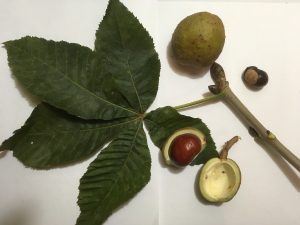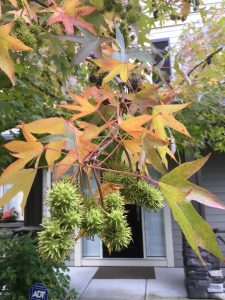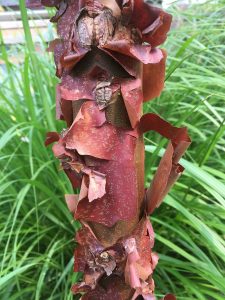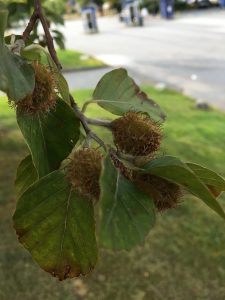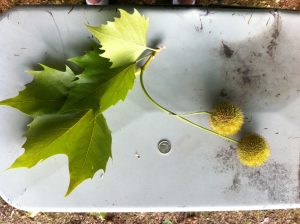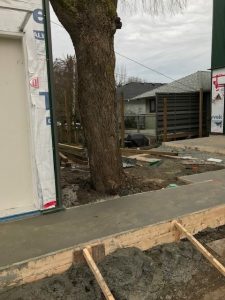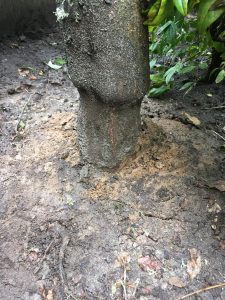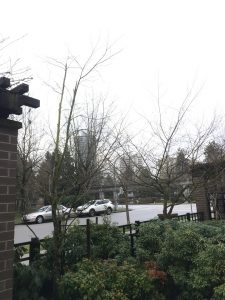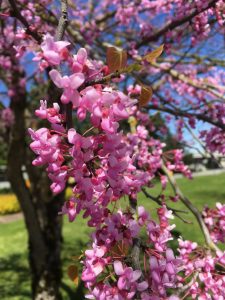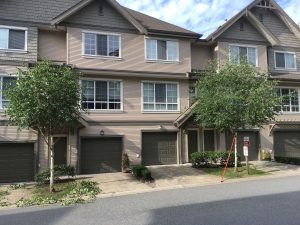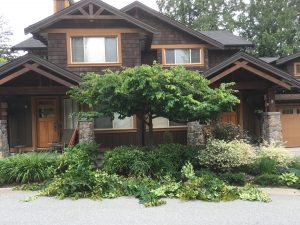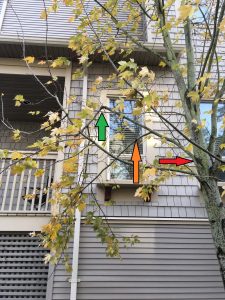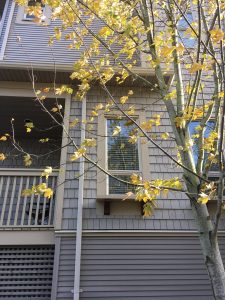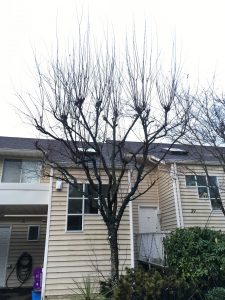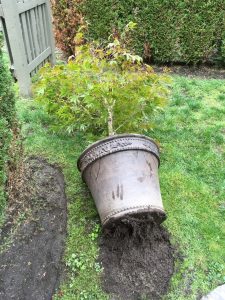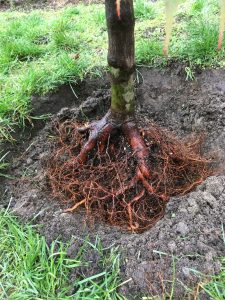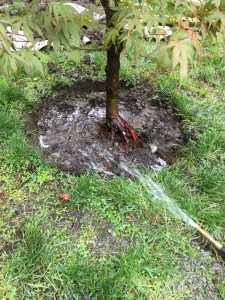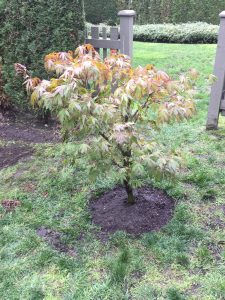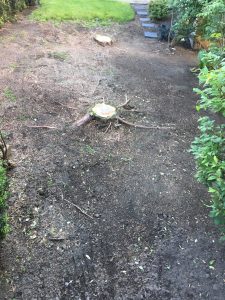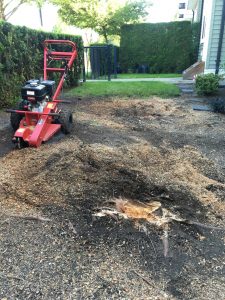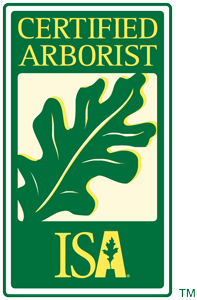I read the Globe and Mail newspaper regularly but I often ignore the latest news. Instead, I look for interesting stories and recently I got lucky. I found a story about a Toronto street horse-chestnut tree (Aesculus hippocastanum). It’s almost a love letter to a lost friend.
The writer had a huge specimen in front of his house and one day city crews came out to remove it. They showed him how the hollow areas inside made it likely that it would collapse on the sidewalk or street. It was in everyone’s best interest to remove it and plant something new.
The story reminds me of how trees can become your friends, even if they annoy you by dropping stuff all year. Flower parts, chestnuts, leaves, etc.
Even I remember doing crafts with horse-chestnuts as a kid. I recall we made animals out of them. And now, many years later, I still can’t resist picking up the shiny brown chestnuts. Then I forget them in a work truck and the boss freaks out.
As soon as the tree was removed the author immediately noticed the lack of shade; and, of course, trees provide many free ecosystem services, shade is just one of them. The street also didn’t look the same post tree removal. Large trees give streets character.
There is lots to like about horse-chestnuts. The large prominent flowers look great, the leaves and buds are huge and the chestnuts are fun to hold and look at.
The author’s municipality offered him a free replacement tree and, of course, he will plant one. He just won’t live long enough to see it mature into a giant. And that’s fine. We need more trees to give cities some character and to combat Global Warming.
There are many beautiful landscape trees in our gardens and landscapes and some are easy to identify. We’ve covered five easy to identify tree species in a previous blog post and here we continue with five more. Do you know them already or are they new to you?
Sweetgum (Liquidambar styraciflua)
The sweetgum tree is a nice alternative for places where maples dominate. The pointy leaves resemble maples but what gives away the sweetgum are its hard spiky fruits. When you see them, you know its a sweetgum tree. They remind me of spiky floating mines from war movies.
Paperbark maple (Acer griseum)
The common name gives it away but as soon as you see the gorgeous cinnamon coloured peeling bark, you know it’s Acer griseum. Sometimes, when no one is watching, I peel one section of the bark just for fun. This is beautiful landscape tree.
Horse chestnut (Aesculus hippocastanum)
There is lots to look at on the Horse chestnut. The buds are huge and so are the leaves; the key identifier is the inedible chestnut.
European beech (Fagus sylvatica)
The key identifier are fuzzy cupules which contain triangular beechnuts. Wait for the cupules to open up or take some home. They will pop open in your kitchen. My wife loves this.
London plane ( Platanus x acerifolia)
The London plane leaves are huge and the key identifier are the spherical fruits produced on long stalks. You will never forget this tree if you get close enough. I don’t suffer from any allergies but this tree can make me cry. That’s because young leaves shed short stiff hairs and so do the fruits. Backpack blowing around these trees is a nightmare.
London planes are also extremely effective at removing pollution.
Now, it’s your turn to practice identifying these five trees. They are easy to identify especially now that you know what to look for.
Get ready for volume 3.
Proper tree planting is extremely important so when I got a chance to judge a tree planting and staking practical station, I jumped at it.
The landscape industry certified practical tests run twice a year, in June and October but there will be major changes from 2020. Stay tuned.
Planting and staking
Incredibly, I had to do this section three times. My ISA certified arborist status didn’t help me because I failed to follow the specifications. And while I can’t comment in detail on any of my seven candidates, I can say that a few of them didn’t follow the written specifications.
The second time I failed this station was because I totally forgot to put on a headset during stake pounding. Safety is also super important. If you fail to use the provided personal protection equipment, you will most likely get a few deductions.
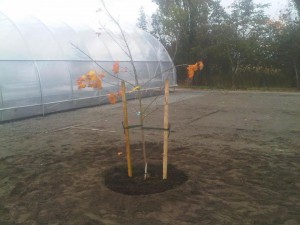
My historic third attempt, finally done correctly, and giving me the prized Landscape Industry Certified technician status.
Planting depth
As a judge, I can’t give away the station’s secrets but let’s just say that planting the test specimen too deep is a major problem. And rightly so because landscape trees planted too deep suffer. They suffer because their roots can’t get enough oxygen. Then, when they decline and die we have to replace them which is costly. Let’s do it right the first time.
Mulch
This is another serious issue. My blog post from September 10, 2019, covered the mulch volcano epidemic. Luckily, my candidates have clear specifications to follow. The key is that there must be a few inches of soil clear between the tree trunk and the mulch. This eliminates any chance of mulch volcanoes.
And if you haven’t read my September 10, 2019 blog then go back and review the problems associated with tree mulch volcanoes.
Staking
Some newly planted trees must be stakes; and staked correctly. Once you follow the specifications, all you have to know is that the stakes shouldn’t stay on for more than one season.
Conclusion
Not all of the candidates I judged passed but I had a great time judging the tree planting and staking stations. I had a manual to follow and the other veteran judges helped me.
Incorrectly planted landscape trees suffer, decline and die. Then we lose their free ecosystem services at a time when more trees are required to fight Global Warming.
At last year’s CanWest Hort Expo I attended a lecture by local tree expert Dr. Julian Dunster. During the lecture he made a key comment about trees in construction zones. There is so much disturbance on some construction sites that it’s better to remove all trees and start over.
But in practice people fight to preserve all trees on construction sites. I was in that camp myself until Dr. Dunster showed that most trees on severely disturbed sites will not survive for long. It may be best to start over by removing the existing trees and planting new ones.
One recent example
I recalled all of this when I saw a picture someone had posted in a Facebook group. Take a look. What do you see?
It’s not a pretty picture and it fits Dr. Dunster’s lecture comments. It’s possible that the people in charge of this project couldn’t get a tree removal permit or that it cost too much.
Structural roots
I’m not a construction expert but I do know that there must be a foundation in place for the structure on the left to go up. Now, considering the size of the tree, I’m almost certain that big, structural roots had to be cut before the foundation could go in. And when this happens, the stability of the tree is compromised.
Compaction
I don’t see any orange exclusion fencing around this tree which means there was a lot of construction activity around its root zone. This activity leads to soil compaction which is a silent tree killer.
Why? Because compacted soils prevent surface water from percolating down to the roots where it’s needed. The water just runs off compacted soils.
Also, the fine roots just under the surface which collect water and nutrients for the trees can’t do their job in compacted soils.
Conclusion
I believe this site should learn from Dr. Dunster’s experience and remove the tree so a smaller specimen can be planted instead. I can’t see this tree surviving for long. Start over.
I was recently sent to a new strata site to re-stake a Japanese snowbell (Styrax japonicus) tree. The owner was concerned because the tree was leaning on his gate. So I picked up the required tools and materials for tree staking: stake pounder and a headset, two stakes, arbor tie, and a staple gun.
A sad specimen
Compared to its cousins in neighbouring yards, this tree wasn’t doing as well. And I wonder why? It has fewer branches thanks to past pruning, and there is a distinct bump on the trunk close to the ground which almost looks like the result of previous injury or girdling.
First, I removed the old stakes. Tree stakes shouldn’t stay on for more than a year and clearly this tree is older than one year. Then I installed two new stakes so the tree wasn’t leaning anymore. When I moved the tree trunk, the root ball moved as well.
This is where the unscientific “wiggle test” comes in. I learned about this test from Dr. Linda Chalker-Scott. When you gently move a tree trunk the root ball shouldn’t be moving on healthy, well-established trees. The same is true of shrubs.
On this Styrax there was a lot of movement so I jumped over the fence into a neighbouring yard and performed the same test on another Styrax. The trunk moved but the root ball held nicely suggesting that the tree is well-established and healthy.
I used a staple gun to attach the arbor tie to both stakes and I had just enough staples for the job. Always bring spare staples and extra stakes just in case things go wrong.
Future
I worry about this tree because it should be well established like its cousins nearby; I’m assuming, of course, that all of the trees were planted at the same time. When I performed the “wiggle test“, the root ball was moving which is bad. Considering the size and age of this Styrax, it should be nicely established. But, since I’m new on this site, I have no idea what happened in this yard in previous seasons.
If you have doubts about trees and shrubs in your gardens, try the “wiggle test“. It’s unscientific, but it gives you a good indication about the health of your plant.
I openly admit to quickly scanning my weekly issues of Tri City News and moving on. But, in late January I noticed a great headline. “PoCo wants big boost in trees” , TriCityNews (Thursday, January 24, 2019, section A9). More trees is like music to my ears.
The Port Coquitlam city council wants to plant 350 trees every year until 2060. This would increase the city’s tree canopy from 23.8% to 25% in 41 years.
But Councillor Laura Dupont doesn’t think the targets above are ambitious enough. She wants to see a 30% canopy cover by 2035. I love it. If I lived in Port Coquitlam I would vote for Laura Dupont and nominate her for some sort of community award.
Money
The problem with Dupont’s target is lack of money. Planting trees is expensive. To raise funds the city will collect $100 from homeowners who cut down trees on their properties. And illegal cutting will trigger larger fines.
Why more trees?
The article doesn’t mention why we need more trees. Perhaps it’s too obvious. So, why do we need more trees and a larger city canopy cover?
Trees provide numerous ecosystem services for free. A larger city canopy cover would cool down the city in summer which may be critical on a planet affected by Global Warming. Paved cities act as heat islands and green spaces provide cooling.
Last year there were reports from India about a big city suffering, I mean really suffering, through heat waves. Then somebody noticed the complete lack of green spaces. It’s a huge mistake to eliminate green spaces from cities.
Trees also remove air pollutants and they produce oxygen. And who doesn’t like free oxygen?
Trees also look great. Many tree species are beautiful and they provide food and habitat for animals.
Green spaces also make people happier and safer.
Conclusion
The Port Coquitlam city council’s plan to plant more trees every year until 2060 is a brilliant idea. Trees provide numerous ecosystem services for free. I can’t wait to see what tree species they plant.
Now that our deciduous landscape trees have lost their leaves we can clearly see the branch structures. And as I recently removed one broken branch I had a flashback to summer. And a blog post was born. So let’s consider the basic differences between summer and winter tree pruning.
Summer tree pruning
As trees flush out in spring strata property residents freak out about encroaching branches. That’s when I get called in.
Summer tree pruning is light because sunny days are already stressful enough for our landscape trees. Trees also store food in branches so removing too many could pose a problem for the trees. Remember, under drought conditions trees shut down their leaf openings to prevent moisture loss; this also means that they can’t produce food and must rely on reserves.
Most of the pruning requests revolve around crown shape and branch encroachment. Since the branch structure is hidden under foliage it’s best not to make too many radical cuts.
In the first example below you can see what the strata council wants: all birch crowns are to be tightened up. Nothing radical.
In the second example below, the owners want this Parrotia persica (Persian ironwood) lightly shaped so it’s off the building. Again, nothing radical. The lady loves the finished look.
Winter tree pruning
Now consider winter tree pruning. Since the leaves are gone we can see branch structures well. And all of a sudden I’m finding broken branches in crowns that were until recently covered up by leaves.
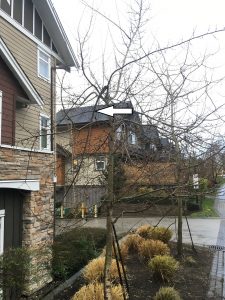
Broken branches must be removed (see white arrow).
Horror show
Not all winter tree pruning is enjoyable. Some strata complexes have their trees topped and, of course, the trees notice it. Then they produce extra sprouts from the cuts and we have to remove them annually. And so the cycle begins.
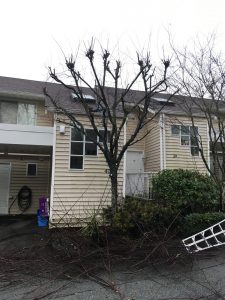
All done! I’ll be back in 12 months.
Conclusion
Leave harsher tree pruning for the winter when the trees are dormant and their branch structures are clearly visible. If you must prune trees in summer, do it lightly.
Bare root tree planting is recommended by my mentor Dr. Linda Chalker-Scott but in strata maintenance we rarely have time for it. There is often pressure to dig holes and plug the trees in.
I got my first taste of bare root tree planting when I worked at a municipal parks department in the fall of 2014. And I’ve been waiting for a chance to do it again solo. Patiently.
Lucky Vas
Then I got lucky this past October when a strata owner approached me about transplanting her Japanese maple (Acer palmatum). The poor tree had some problems. It had dead wood in the top leader and the roots had penetrated the lawn from the bottom of the pot. The lucky part was that the maple was planted in fluffy potting mix media, not in decent soil. So when I finally liberated the tree from its pot, the potting mix stayed in the pot and I was left holding a bare root tree! Brilliant!
Why bare root?
So what’s the advantage of bare root planting? First, the roots can be examined, pruned and rearranged. They should look like spokes on a wheel, not circling the way they do in pots. Second, nothing else is added to the planting hole. No burlap, strings or wires; and no clay bombs.
Lawn home
The new tree location was in the lawn which isn’t ideal because lawn grasses compete with trees for water and nutrients. I’m sure the new tree well will help channel water down to the root zone.
I did some minor root pruning on the tree and I forced the fibrous roots to stick out like spokes on a wheel.
Stability
I always wondered how bare root planted trees stay upright in the hole without staking. Some large trees do require staking; just don’t forget to remove the stakes after one year.
The procedure is called ‘mud-in‘. You take the parent soil material and you add some to the hole. Then you water it in to create mud. Wait for a bit and repeat the same steps, until you reach the root flare. Then we stop because the root flare has to stay above the soil.
I gently tested my maple and it felt solid. I watered the tree again with a slow soak and instructed the owner to do the same going forward. Now we wait and see if the tree lives. It should be happier in the soil.
If you read my blog posts consistently you will know that I’m not really a machine kind of guy. But as I found out, learning to use a new machine can be a fun way to spend your day and it stretches you a bit. This is exactly what happened on my stump grinding day.
The goal
The goal for the day was to annihilate the two stumps, level off the bed with new soil and install a row of cedars (Thuja occidentalis ‘Smaragd’) to separate the two units.
Step 1
I rented the stump grinder at Home Depot. It’s cheaper if you can fit all of your work into four hours. Otherwise you will have to pay for the whole day.
Because the machine is heavy my boss had suggested asking a passerby for assistance. Unfortunately, I only saw teenage girls heading to school and it would have been suspicious asking them for help with a stump grinder. So I called for help.
There is only one trick to the machine. When you’re ready to stump grind, activate the black lever on the left. It locks the left wheel in place allowing you to rock the machine blade side to side over your stump. That’s it.
I really enjoyed doing this by myself without anyone kibitzing and it worked out. Only later I learned that a little boy in the window had a blast watching me.
Once the stumps are erased, you will have to rake up the wood debris and remove it. Also, don’t forget to clean up the machine or the Home Depot attendant will have a fit.
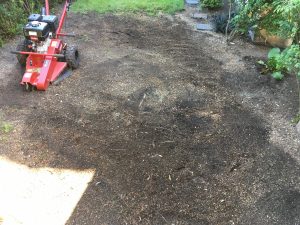
Ready for soil install.
Cedar hedge
Digging through the middle of this bed was actually very hard because I ran into heavy clay. Soils in the Lower Mainland are mostly clay but it’s hard to tell because new developments sometimes have engineered soils installed. And they don’t look anything like the native soils.
New cedars installed in spring will require consistent watering so they can get established. Both units were alerted but sometimes I wonder. I reminded them to slow soak the cedars; quick spray from a hose isn’t really watering.
The new grass seed, on the other hand, will need gentle sprays to achieve germination in one week or so.
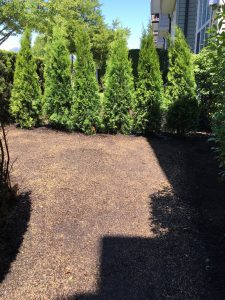
All done. Stumps are gone, the area is level with new soil and a new hedge is in. The lawn will require at least a week for germination.
This was a fun day for me because I got to transform a bare area into something new. And in the process I got to practice stump grinding which means that next time I will be super confident. Both residents were delighted with the change and promised to water religiously. God help them.


